Noam Gagnon-Bullfighters & Wondrous Polaroids
Saturday, September 29, 2007
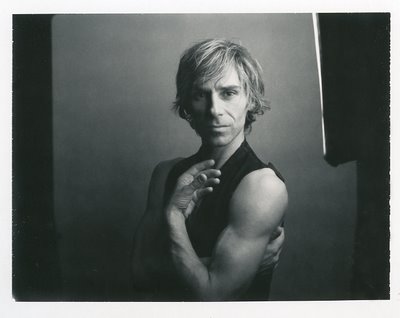 In recent years I have simplified my photographic technique and kept it simple. I remember once in actually bragging that I had used 8 different lights for one shoot. At the same time I have kept in mind that we live in a one star system. This means that at any given time when we are outside we will cast only one shadow. If there are any inhabitants in the triple star Centauri System they would cast more than one shadow. In the last few years I have come to like using a 3x4 ft softbox (a rectangular nylon box with a flash on one end and an opaque nylon cloth through which the flash shoots through). You can see part of it on the right hand side of this first photo which is a scanned b+w Polaroid of dancer/choreographer Noam Gagnon who is one half of the two-person dance group Holy Body Tattoo. The other half is Dana Gingras. I like to position my subject not too far from my medium gray wall and then I get my 3x4 softbox as close as I can to my subject. Depending on how far from the wall and how near my softbox is, that gray wall can go from almost black to a light gray. If you look carefully at that Polaroid you can see that on Gagnon's right hand side of his face there is a little Rembrandt upside down triangle of light. I like to play with that triangle. I can make it more intense if I ask Gagnon to ever so slightly rotate his nose towards the light on his left hand side. I like the mystery and the drama of this lighting. But it is important that the dark side of the face have a slight light or an indication of it in the eye. 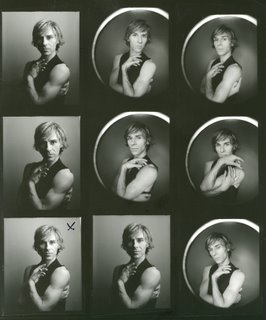 This is my present style. But it clashes completely with the needs of the Georgia Straight which uses cheap newsprint and an economical printer. This means that true blacks usually reproduce as muddy dark grays and so on. They would reject this original Polaroid as they would the 10th exposure (it did not fit into the contact sheet of 9 exposures). I also rejected it as I did not think the portrait was strong enough with the smile. Gagnon recently spent some time in Spain and he told me that there was something of the bullfighter in his three pieces. Of all the shots I took of him the one that I picked is the one that to me looked the most had I photographed a bullfighter and not the dancer. Only in that frame was Gagnon's neck stretched out to look like that elegant bullfighter Paco Camino I so admired in the 60s. 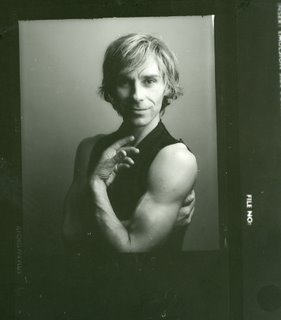 I took one Polaroid for each of the two setups you see here in the original contact sheet of only 9 shots (the 10th exposure did not fit on it). Gagnon and I decided we liked the second setup with the softbox as opposed to avant-gardish ring flash one. 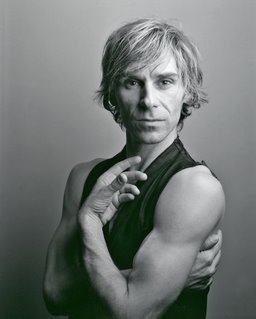 In the contact sheet the x marks the photograph that is running in this week's Georgia Straight. You can see what it looks like by comparing the dark x one with this one which is the one I sent to the Straight. But with all my recent fiddling with my new Epson V700 scanner that gives me more of the inherent sharpness of my original Polaroid (as opposed to my older Epson 1640SU) I have come to see the Polaroids as objects of beauty. 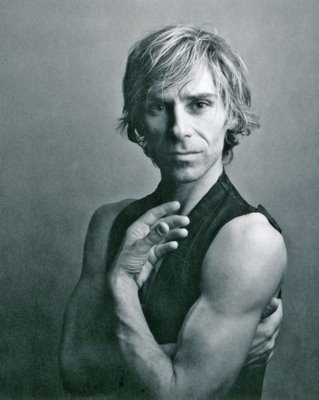 As you lighten them the background gets an interesting mottling that I like. And when I scan these original b+w Polaroids as four colour they develop a slight cool blue tint that I find charming. This picture on the left is the original Polaroid from the top scanned to my satisfaction. My camera enables me to either use Polaroid (on a Polaroid back) and or film on a film back. Before any portrait session I take a Polaroid first before switching to negative b+w film or colour transparency. More and more, of late, that first Polaroid is becoming my favourite and I don't even shoot straight film anymore. Noam Gagnon will be appearing next week at the Vancouver Cultural Centre beginning October 2.
An Original, A Facsimile & The Three Miracles At The Wedding at Cana
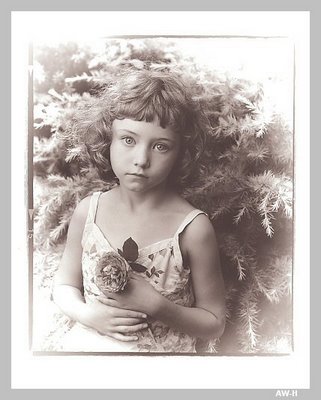
You see here a scanned b+w negative of Rebecca Stewart my granddaughter posing in my garden while holding the English Rose, Rosa 'William Shakespeare'. When I saw this picture on a contact sheet I thought of the portraits of Alice Liddell by the Reverend Dogson. I sepia toned it with Photo Shop to give it that 19th century look. Then I found under my darkroom enlarger (it sits on an old and massive oak library table), an envelope with five 16x20 inch sheets of Agfa Portriga paper. Before Agfa disappeared a few years ago they had already discontinued this premium paper loved by most of us who printed portraits or landscapes. When you immersed this paper in concentrated solutions of selenium toner, you got what is called split toning. In some areas of the photograph you would get warm tones. These warm tones would be next to cool tones. The overall effect was one that almost looked like three dimensions. You can see the effect in this scan of a smaller Portriga print of a view in VanDusen Botanical Garden. Click on it to see it in more detail.
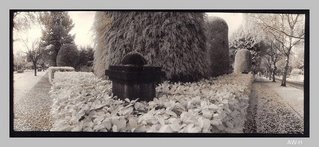
Because the paper was old my three prints of this picture (and two of another negative) were even more special. The whites were no longer white. They were a dirty white that added something that I could never or will ever be able to duplicate. Those three prints of this negative are originals. But there is one possible solution. Read on.
I have reluctantly signed over the rights to particular photographs of mine only for considerable money or when I have been desperate for it. I remember that the National Film Board called me about 7 years ago and wanted me to take stills for a project of theirs. I was delighted until they asked me if I were willing to hand over my original negatives. I told them that with the digital revolution a scan of an original was as good as the original. They did not buy this. So I did not work for the National Film Board.
I routinely photograph lawyers, writers, artists and I may give them high resolution scans of the photographs. They are happy and I am happy to keep my original slide or negative in my files. To me that negative or slide is the only original.
Today I read about Veronese's The Wedding at Cana which was removed from Venice and taken to France by the victorious Napoleon, who also ended the Venetian Republic. The French have "returned" an exact facsimile, even to the bumps and imperfections of the original. To me this article buried in today's New York Times's arts section is a harbinger of things to come. As it becomes increasingly impossible for art galleries of impoverished nations to pay for the necessary travel insurance to transfer works of arts from one museum to another we are increasingly seeing shows of lesser known masters or lesser known works of those masters. Perhaps only the Metropolitan Museum of Art in New York could persuade and pay the insurance so that the Louvre might sent Leonardo da Vinci's La Gioconda.
But all that could change. We in Vancouver will some day gaze on an "exact copy" of La Joconde while not being surrounded by hundreds and hundreds of eager tourists. We will rationalize that this will be better than spending the money (which we might not have) to go to Paris to get a three minute (if we are lucky) glance at the original. As increasingly more people gaze upon "originals" such as the on line versions from the Tate Gallery, as an example, could this be a good thing?
The Real Thing
The Real Thing again
Linda Goes To School & So Do We
Friday, September 28, 2007
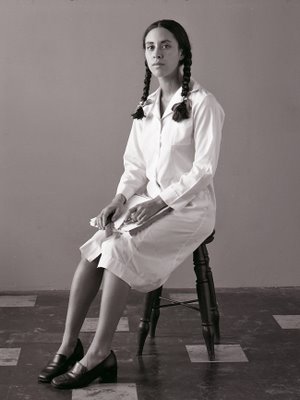 Shortly before my mother died in 1973 (she was 62), I remember her telling me, "Alex I have been in school all my life." This is because she had been a teacher until 1970 when her Meniere's Disease completely took away her sense of balance and she became deaf. Her mother Lolita had been a teacher and so was I until I came to Canada in 1975.
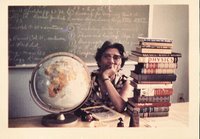 Rosemary and I met teaching and we taught in Mexico until we left. In our present family our eldest daughter Ale is now keeping with the family tradition. She has always wanted to teach native children. She has her wish as half her 10 student kindergarten class, in her new job in a school in Lillooet is native. She moved there in July. I bequeathed to her my hardcover copy of Teaching As A Subversive Activity by Neil Postman and Charles Weingartner.
On Monday, since both of Lauren and Rebecca's parents were at work, Rosemary and I went to parents-meet-teachers day at L’École Bilingue. We sat on tiny little chairs in Lauren's kindergarten class and both of us experienced a special little thrill to see Lauren's name taped on the floor which marked where she sat. We were amazed at the amount of paper work her teacher has to go through. But we also found out that all the paper stuff that Lauren and Rebecca have to take home is now available by email. In Rebecca's split 5/6 class (Rebecca is in grade 5) we were barely able to comprehend how one teacher went twice a week, another three times a week and that a third taught the class mathematics. I was amazed to find out that these teachers welcomed email communication with parents. I am not sure that as a teacher I would want a meddling parent communicating with me daily (were she that meddling of a parent).
Being in Lauren's class shot me with nostalgia. I remember just about everything I did not only in kindergarten but in pre-kinder in Buenos Aires. In kinder, the famous Diligenti quintuplets (three girls, two boys) were all in my class. I may have been precocious before my time as I distinctly remember lifting the girls' skirts up on a few occasions. I remember fighting to be able to play the sandpaper blocks and being humiliated in having to play the triangle. It was the sissy instrument par exellence. It was in segundo superior (a sort of second grade for somewhat super achievers) were a photographer took our class picture and used a metal pan with phosphorus or magnesium powder. We would line up in lines before entering class and we had to extend our right arm and touch the person in front on the right shoulder and maintain that distance. It was called making distancia. In kidergarten we were given a little bottle of milk and cookies. I do not recall anybody ever having an allergy attack. After our meal we would rest our head on our desk for descanso. Very special to Argentines is the almost universal uniform which is a white smock (much like a nurse's or a doctor's) and it is called a guardapolvo (it literally means, it keeps the dust away). I wore one.
But what I remember the most is the smell of my classrooms. It was combination of the scent of real chalk dust (when blackboards were black and made of slate and not the easy-on-the-eyes green) and the pungent smell of the ink from the inkwells in our desks. And, yes we used papel secante (blotting paper) which had a particular smell of its one. I have some Kodak blotting paper still with which I sometimes dry my photographs. I remember the fear of having the yearly dyptheria vaccine. It was an injection that was on one's spinal column. To this day I will take a pill when given the choice over an injection.
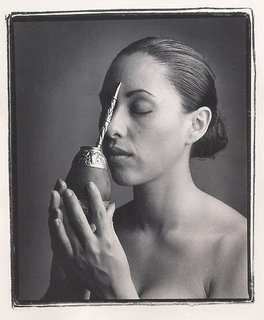
A few years ago my Argentine friends and artists Juan Manuel Sanchez, Nora Patrich and I decided to have a show called Nostalgia. In this show with one model, the lovely Argentine Linda Lorenzo, we dressed her (and undressed her) and modified her looks to suit our fancy. We made her fit our rosy ideas of our past in Buenos Aires and Argentina. It was Nora who suggested the school girl. She found her old school girl guardapolvo (Nora never threw out anything) and we dressed up Linda. We didn't do this in the spirit of that Japanese fetish for schoolgirl uniforms. We genuinely tried to evoke our days in school.
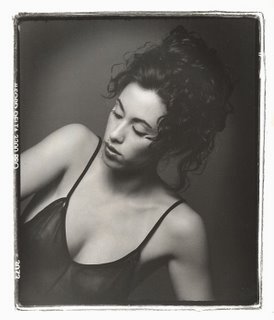
Somehow the extremely curvaceous Linda understood our purpose and managed to look all proper in the uniform and I was delighted to take the shot. I am including a couple more of Linda to show that her talents surpassed our skills.
Carole Taylor -Vancouver Mayor ?
Thursday, September 27, 2007
 My first direct involvement with politics happened in 1966 when with a Mauser on my shoulder I watched President Arturo Illía go home in a cab. Since then I have taken democracy very seriously. As soon as I became a Canadian citizen I began to vote municipally, provincially and federally. I don't quite understand Canada's parliamentary system. Nor do I understand how the Prime Minister has so much authority to appoint such positions as the Supreme Court Justices without any form of parliamentary check or approval. During an assignment for a local business magazine to cover a Socred convention in Whistler some years past, I was flabbergasted to see how politicians who were not getting the votes that they expected, would "cross the floor" (they had to do this physically and it was patently humiliating) to give support to someone they had loathed and spoken ill of in their speeches. But I have admired and enjoyed the freedom that our politicians have to move around at will in our city. In his worst moments of unpopularity I waited for Premier Bill Vander Zalm to photograph him with a buddy from Holland (who was into trains) as they inspected CP's rail yard behind the old CP Train Station. Vander Zalm arrived, parked his Volvo across the street on Cordova and before he crossed the street to meet me he put coins into the meter. He was dressed in a smart black leather jacket. There was not one security man in sight. I enjoy discussing politics with my friends Mark Budgen, Ian Bateson, Abraham Rogatnick and Sean Rossiter. Occasionally my right-wing friend, ex Fraser Institute David Hanley surfaces and he adds to my mix. The first thing I do in the morning when I pick up my Vancouver Sun is to look for Section B to read about Vancouver politics. In Wednesday's Sun I did not find one reference in Section B on the fact that we are living through a long city strike. To my amazement I read in Allen Garrs'column, titled, Ladner Courted for provincial run, in my Wednesday Vancouver Courier, that there is a big chance that our next mayor will be Carole Taylor. She would not run provincially and her provincial seat would go to the miffed and ignored (Garr was precise in saying that any reference he made to our lofty loonie was not a reference to ",....His Worship") NPA Councillor, Peter Ladner. This sort of news would make banner headlines in any other big city daily in any part of the world, (It is becoming hard here not to break my rule of never ranting in this blog!) or it would have been mentioned on CBC Radio. So with Courier in hand I went to get a haircut with my local Kerrisdale hairdresser. I told Richard Jeha what I had read in the paper. He was astounded. Could it be that only in Vancouver would the hairdresser be the last person to hear such news? And, even after this badly uninformed citizen of Vancouver? Thankfully I could be worse informed. My friend Mark Budgen is a shrewd observer and knows much more than meets the eye. When I called him one day to ask why it was that Allen Garr, an avid bloodhound at the heels of the NPA, had only marginally slapped Ladner's wrist for writing a column about the city strike for the Vancouver Sun (and the Sun should have at least featured a column my a union member to counter Ladner's) he explained to me about the relationships that reporters have with their sources. It sounded like spook speak to me. Budgen said that a reporter's duty is to protect his or her sources, but at any given moment a reporter should be able to let go and burn his or her source when absolutely necessary, if editorial independence is to be maintained. This is why reporters on a city beat (like the Vancouver Sun's Frances Bula) should be re-assigned. If they linger in their beat they lose their independence and become PR pipe lines for their sources. It is Budgen's theory that Ladner is Garr's source at City Hall. Garr was then unwilling to burn Ladner when Ladner wrote that Sun column.
Lisa - The Kitchen Goddess Of The Arch
Wednesday, September 26, 2007
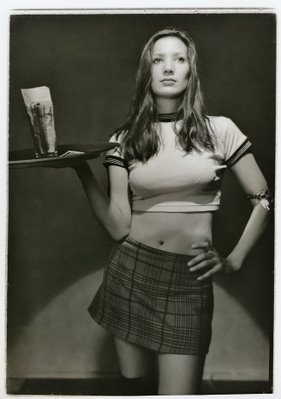 In the mid 90s and even into the first year of the 21st century a group of four architects (not quite, as one was close to being one but wasn't), one freelance journalist and one Vancouver Sun writer would meet on Thursday early evenings for beer at the Marble Arch. Without getting into trouble I think I can name Sean Rossiter as being the freelance scribe in question. I would occasionally attend these gatherings, bracing myself to tobacco fumigation as a couple of the architects smoked lots. They would order pitchers of beer and talk about golf, sports and comment on the salient attributes of the women on stage. I never did drink and I abandoned pipe and cigar smoking about 15 years ago. But this is the closest I ever got to the idea of male bonding. For me it has been always difficult as I don't fish, golf or do any sports or care for hockey. I felt like an interloper but I was made welcome. I marvelled at how these guys would suddenly know they had had enough to drink and no matter how interesting the conversation or the sizable beauty of the dancer's attributes these guys would stand up and go home. I felt like a wimp as I only drank soda water. If Tony Ricci, the guy who ran the joint, happened to be there we would be unable to pay for any of our drinks. I received unlimited soda waters. Even when Tony wasn't there, Danny the Greek would send a tray of flaming Sambucas our way. We would toast in his direction and down the hatch the concoction went. Since we were all Canadians, we exercised our male right to eat a hamburger while watching a woman undrape (as they say at Emily Carr Institute of Art and Design). We had gained this right by going all the way to the Supreme Court of Canada via our proxy, Gary Taylor, God bless him! The menu was brought by a variety of employees who were in that Never-never land of not being exotics or sassy waitresses. Tony Ricci would have thrown us out if we had ever called any of them servers. After all he had literally hand picked them. So the persons emerging we gave several nicknames and our favorite of all was Lisa The Kitchen Goddess. She was intelligent, slim and tall. She served us well and when I requested she pose for me in my studio she did. For this photograph I used the unlikely combination of a very sharp and fine grain film called Kodak Technical Pan Film with a terrible, unsharp, single focus box camera called a Bessa with a 6x9 cm format. Little by little the architects went their separate way. The Arch closed and I have never seen Lisa the Kitchen Goddess again. If Danny is no longer with us I am sure he is serving flaming Sambucas somewhere up there.
Louis de Bernières's Mandolin & The BMW's Advance/Retard Lever
Tuesday, September 25, 2007
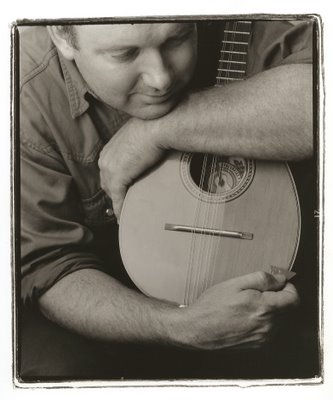 Driving past the Stanley Park rose garden last week on my way to West Vancouver I noticed that some of the roses had not given up yet. Some of them had buds but they will ball up with the recent rain and cooler nights. I saddened at the thought. My melancholy dissipated as I thought of a happier time that happened this week but back in 1995. I was driving to Horseshoe Bay in a maroon Maserati Bi-turbo and my passenger, the English writer Louis de Bernières, turned from looking at the roses, fingered the single mandolin string we had purchased at Ward Music (then on Hastings) and said through some unspoken chain of connections, "My grandfather, my father, and I all had a bad right leg because of our fascination with motorcycles." He was speaking to me in the tangential magic realism of his early books (The War of Don Emmanuel's Nether Parts, 1990, Señor Vivo and the Coca Lord, 1991, Cardinal Guzman, 1992) and has what seems to be a symbolist's fascination for motorcycles, Lee Enfield rifles, his grandfather's life story, and mandolins. Earlier that day, when I had entered his room at the Holiday Inn on Howe Street, I was surprised to see a case for a flat-bottomed mandolin. De Bernières said: "Yes, there's a mandolin inside it. I have three. I have a nice round-backed Italian one, the sort that slips about. It's a fake Italian one from Czechoslovakia. I have an absolutely exquisite one from Portugal. It's a flat-back and it really sings. Even the bass sings, unusual for mandolins, which are quite trebly. And this is my traveling mandolin. It's a Portuguese imitation from Spain. It has no volume, so it's ideal for hotel rooms." Removing it from the case, he sat down to play Vivaldi's Concerto for Mandolin in C major. De Bernières was in town to promote his then latest novel, Captain Corelli's Mandolin. But at the same time he was taking advantage of this North American leg of his tour to search Nanaimo for traces of his grandfather, who disappeared from England in the 1920s and surfaced in British Columbia in the 1950s. "People ask me if I am going to write about him. He was 96 when he died. He had a long and picaresque life which ranged from Ceylon, Africa, the Northwest frontier, First World War, the RAF in the Second, and so on. I would love to turn it into a novel but my father and my aunt are still alive. I could cause some hurt and upset. Mario Vargas Llosa (the above listed trilogy by de Berniéres reads like translated Vargas Llosa on acid) upset his relatives with Aunt Julia and the Scriptwriter. So did Isabel Allende. Maybe they think that art is more important. I don't." He explains in obscure fragments, how his grandfather ended up in B.C. "My grandfather had a misunderstanding with his daughter, my aunt. He thought she was going to get married in New Zealand. He waited and waited to hear from her and didn't. As it happened she had not married and had stayed where she was in England. It was a futile misfortune." Searching for his daughter, whom he never heard from again, de Bernières's grandfather came to Canada. Quiet and self-effacing, de Bernières rarely volunteered information. His remark on his family's fascination with motorcycles came only when I asked him why he had so painstakingly described a BMW motorcycle's advance/retard lever in Captain Corelli's Mandolin. When I asked him if he played the mandolin because he was a failed violinist, he replied, "I did play the violin for a while and my cat would howl, but no. I played classical and flamenco guitar until I damaged the ligaments of my hands." While talking about Spanish Guitars, de Bernières confided: "The three members of the military junta in Don Emanuel are named after the three most famous guitar-makers in Spain. And that Canadian poet living on a Greek Island in Captain Corelli's Mandolin is your Leonard Cohen." As I dropped off de Bernières at the ferry terminal I wondered (and still wonder) whether I'd ever find out how his grandfather(not to mention his father and himself) hurt his leg with a motorcycle. I hoped then and hope now, that he might risk offending his father and aunt. We would be richer for it.
Jim Cummins - Avant-garde Forever
Monday, September 24, 2007
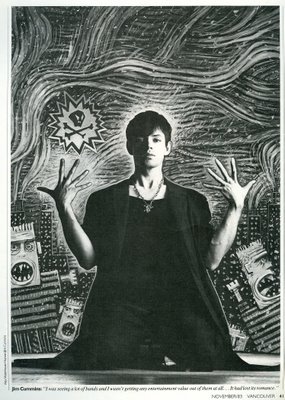
When I took this picture of artist and musician Jim Cummins a.k.a. Braineater in October 1983 I may have taken my first photograph where I was aware that a single photograph sometimes could not tell a story or paint a true picture. Cummins posed for me and when he raised his hands I saw the most beautiful hands I had ever seen on anybody. Cummins's studio (he moved as often as his studio's frozen rents were unfrozen) on Water Street, where it intersects with Cordova, had white brick walls. I had an idea. I asked him if I were to make an 11x14 inch print if he would finish it for me. He accepted the challenge while I convinced Vancouver Magazine art director Rick Staehling that this photo would need a joint photo credit. Soon after this photo illustration appeared I hired Cummins to paint both my daughters (Ale and Hilary, seen here) individually. He demanded that I give him some snapshots.
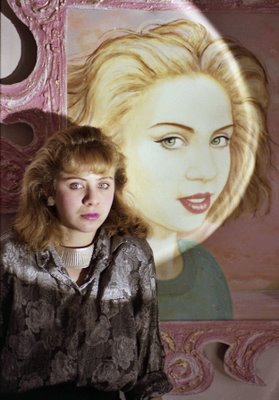
I counter demanded that he, at least, photograph them if he were going to work from photographs. This he did. I have both paintings (very large) at home on the wall and when I look at them I think of the man with the beautiful hands. I think of the man that I run into on Robson Street quite frequently. He is always generous, polite, warm and as friendly as can be. Can it be that the avant-garde can also be defined as generous, polite, warm and friendly? My guess is that it can. Cummins has stuck to his principles of what his music and art should be. He has fun doing it.
If you happen to recognize him on Robson, look at his hands.
The 11x14 finished print of Jim Cummins hangs in the darkest corner of my basement. I don't want too much light to hit it. Without realizing the worth of an archival image I gave Cummins an early Ilford Multigrade resin coated photographic print to work on. While I have always properly washed all my photographs the archival state of this print is in doubt. It looks perfect today. Tomorrow (or soon) I will have the image drum scanned and saved as a digital file.
Safe & Sound In Celestún
Sunday, September 23, 2007
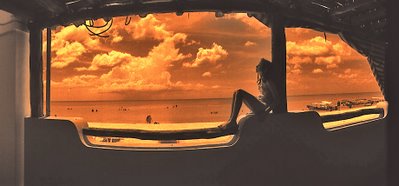 As summer wanes and we think about turning on the furnace I gaze upon this picture of Rebecca and think of the warm (hot, why not?) days we had in our July vacation in Texas and Yucatán. I long for them. When Rosemary, Rebecca and I were in Mérida, Yucatán we had been forewarned by Hilary (my daughter and Rebecca's mother) not to even think about going to a beach. She particularly pointed out Can Cun. Hilary had read too many newspaper reports of Canadians being murdered there. Rosemary had indicated we might have taken a bus from Mérida (facing the Gulf of Mexico with its port of Puerto Progreso) to the seaside resort of Cancun, west in the state of Quintana Roo on the Caribbean. Foreign tourists avoid the placid and extremely shallow beaches of Puerto Progreso. There is no surf and one has to wade in luke warm waters for a long stretch before hitting the deep end. Luckily our hotel, Casa del Balam had an excellent little pool that Rebecca enjoyed several times a day and helped cool her down from the near 40 degree temperatures and a relative humidity that always exceeded 90%. But we did manage to hit a beach once. We visited the Biósfera de Celestún not too far from Puerto Progreso and facing what is the fuzzy demarcation between the waters of the Gulf of Mexico and the Caribbean Sea. These biospheres are areas that the Mexican government has set aside to protect the flora and fauna of the region. This particular one in Celestún featured thousands of flamingos. Rebecca enjoyed the flamingos. Not far from the site was the small town of Celestún with a long beach of white sand. Just like in Puerto Progreso the waters were shallow. It was horribly hot and there was not one palm tree to be seen or a beach umbrella to be rented. I enquired as to the why. A fisherman pointed at a nearby lighthouse. It looked like a miniature version of the Tower of Pisa. Unwilling to fight the elements but unwilling to move to safer grounds the inhabitants of Celestún live and survive through all those hurricanes we in Vancouver read about with the detachment that comes from geographic distance. I took the above picture of Rebecca in one of the few places I found that had some shade. I used my swivel lens panoramic camera, a frequently under performing peace of equipment. This time around it surprised me with clarity and drama (a yellow filter helped) and I don't have to wonder how Celestún braved the hurricanes that followed. I am sure the inhabitants simply shrugged their shoulders and hunkered down.
|























